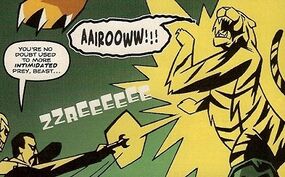Character Assassin (comic story): Difference between revisions
m (Changed protection settings for "Character Assassin (comic story)": Per Forum:Move protection of source pages (see talk page after bot run is finished for details) ([Move=Allow only autoconfirmed users] (indefinite))) |
(corrected publisher) |
||
| Line 18: | Line 18: | ||
|release date = 15 December 2001 | |release date = 15 December 2001 | ||
|cover date = 12 December 2001 | |cover date = 12 December 2001 | ||
|publisher = | |publisher = Panini Comics | ||
|format = Comic | |format = Comic | ||
|epcount = 1 | |epcount = 1 | ||
Revision as of 22:10, 13 July 2024
Character Assassin was a comic story published by Marvel Comics. It was written by Scott Gray, and featured Roger Delgado's Master.
Synopsis
The Master visits the Land of Fiction and murders several other villains.
Plot
The Master arrives at a mansion, serving as a social club for all the villains and horrors of Victorian-era fiction. He wants to join the club and meet the elusive Chairman.
Forced by the unseen Chairman to stand before an arena of these bizarre creatures, he loses a vote to join their club (being "white balled") after calling out their fictional identities. The Master quickly dispatches three of the villains who try to eliminate him. He easily kills the pirate Jas and a great tiger, then rips away the "curtain" of reality to find the Chairman - and creator of these beings — is none other than Professor James Moriarty!
Moriarty's belief in himself to allow him to find the controlling headband used to control the Land. He has decided to surround himself with peers. The Master casually takes the headband, dismissing Moriarty as the least of these characters, merely a plot device to get rid of Sherlock Holmes that failed in his purpose. He sends Moriarty back to his written death at the Reichenbach Falls.
An impressed vampire Count speaks for the villains. He offers the Master the role of Chairman, but the Master declines. However, as they've amused him, he leaves them with a gift — a glimpse at the fiction of the 20th Century, in the form of Martian tripods bringing about their destruction.
The Master knows the headband's technology will prove useful in the real world. He is briefly tempted to remain in the Land and use the headband's power to rule as a god. He dismisses this thought: he'd never be satisfied with a life of mere fiction...
Characters
- The Master
- Count Vlad Dracula
- The Phantom of the Opera
- Jas Hook
- Robur the Conqueror
- Dr. Moreau
- Shere Khan
- Mr Hyde
- Professor Moriarty
- Cerberus
- The Invisible Man
- Captain Nemo
- Fu Manchu
- A. J. Raffles
Worldbuilding
to be added
Notes
- The villains shown include Captain Nemo, Robur the Conqueror, the Phantom of the Opera, Dr Moreau, Count Dracula, Fu Manchu, the Invisible Man, Captain Hook, Shere Khan, Mr Hyde, A. J. Raffles the gentlemen thief, and James Moriarty. Long John Silver and Hook's first mate Smee are mentioned as being members. It is notable that a number of these characters, such as Nemo and Silver, are only debatably villains in their original literary incarnations from the real world, though they are featured as such in some popular adaptations.
- Several characters go unmentioned as they were still in copyright.
- Fu Manchu is treated in this story as one of the 19th century fictional characters, as explicitly contrasted with the 20th century fiction represented by H. G. Wells's Martians. However, in the real world, the character actually debuted in 1913, fifteen years after The War of the Worlds.
- In the Oblivion trade paperback, Scott Gray states he found Professor Moriarty "a rubbish villain" and was annoyed by the Master being compared to him. Character Assassin "stemmed from a simple, personal desire: [Gray] wanted to see the Master kick Moriarty's ass."
- Gray states Alan Barnes came up with the idea of the villains having a gentlemen's club. This meant the villains would need to converse with the Master; Gray has admitted that meant breaking the rule that characters in the Land of Fiction only speak dialogue from their original stories, "but it was worth it".
Original print details
- Publication with page count and closing captions
Continuity
to be added
| |||||||||||||||||||||||
| |||||||||||||||||

